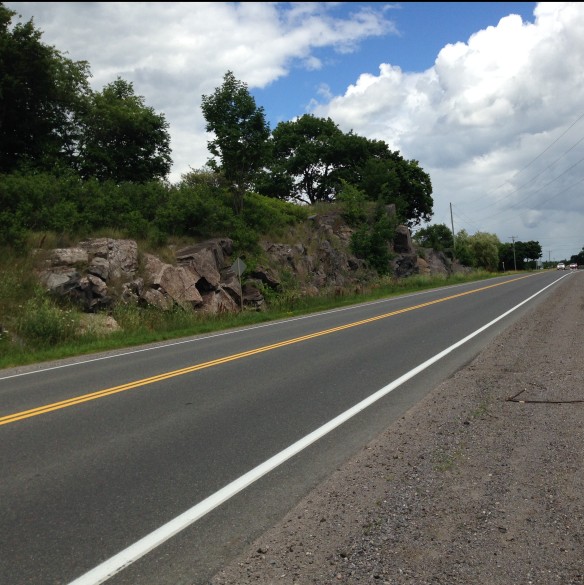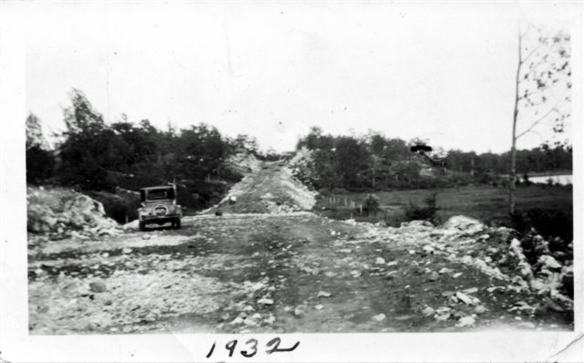
This photo of Highway 7, which I took this very afternoon, gives you a sense, I think, of what a geographical divide it is between “the fat south/with inches of soil on/earth’s round belly,” as the poet Al Purdy put it, and the “lakeland rockland hill country” of the Canadian Shield, as Purdy also said. Note the rock through which the highway had to be blasted.
If you’re a regular, or even occasional, reader of Meanwhile, at the Manse, you’ve probably noticed me using the phrase “north of 7” with some regularity. If you live in or are from the Queensborough area or quite a wide swath around it, you will be instantly familiar with the phrase and know what it means.
But I always keep in mind that it probably doesn’t mean a thing to readers from elsewhere, and so every time I use it I try to get in some kind of an ever-so-brief explanation – often something as simple as noting that “7” refers to Ontario Highway 7.
So I thought it might be useful, both for readers and perhaps especially for me, to try to give a once-and-for-all explanation so that every time I say “north of 7” in future posts I can just link back to this one (for those who are puzzled and want more information) and so that I won’t have to explain it every time.
Okay, so what is “north of 7”?
Well, to begin with – and the main reason why I use the term so often – it’s where Queensborough is, and thus by extension where the Manse is. Living here makes Raymond and me by definition north-of-7 people.
And yes, “7” is Highway 7, or, if you want to get all formal about it, “The King’s Highway 7” – though why ownership hasn’t been transferred to the current female monarch, who has, after all, been ruling for sixty-two years, is kind of beyond me. I have many times linked to the Highway 7 section of the very interesting website The King’s Highway (thekingshighway.ca) that is put together by Cameron Bevers, who has a vast interest in the geography and history of Ontario’s highways. If you’ve never gone to those links I urge you to check them out: go here to get not only some quick facts about Highway 7, but also an excellent recounting of its history, and here to see some great historical photos of it.
But why does being “north of 7” constitute a state of being that is so different from, say, “south of 7” (or, for that matter, “north of the 401,” or “north of Highway 2“)?
Well, I’m no expert in this stuff, but here’s my take on it. People, if you have information to add, or a different perspective on this locally important subject, please share your knowledge in the comments section!
Basically, in Hastings County, Highway 7 (which runs east-west) is the unofficial yet remarkably accurate demarcation between the rich (agriculturally speaking) lands to the south, down to Lake Ontario, and the Canadian Shield. North of 7 is where the soil thins out dramatically, where rocks and lakes and evergreen trees take over from wide-open fields and big, flourishing farms. Yes, there are pockets of reasonable soil and some nice farms north of 7; but they are relatively few and far between. For the most part, north of 7 is a different kind of country altogether.
It is the country that poet Al Purdy so memorably described in his poem The Country North of Belleville. (You can read all about that poem, and read the poem itself, in my post here). Except when Purdy was talking about “bush land scrub land … lakeland rockland and hill country” he really was describing “the country north of 7” more than “the country north of Belleville.” (I think the latter title just sounded better to him, and it is very possible that more of his potential readers would have twigged to “Belleville” in the title than to “7.”)
“This is the country of our defeat,” Purdy says, taking on the identity of one or all of the would-be farmers who tried to make a go of it in the land north of 7 after it was opened up in the 19th century. It is, he says,
… where Sisyphus rolls a big stone
year after year up the ancient hills
picknicking glaciers have left strewn
with centuries’ rubble
backbreaking days
in the sun and rain
when realization seeps slow in the mind
without grandeur or self-deception in
noble struggle of being a fool…
As it happens, there is a just-published book on the very subject of Hastings County north of 7 being “the country of defeat” for early pioneers. It is called The Trail of Broken Hearts (you can read all about it here), and it is by Paul Kirby, a writer and publisher who has done an enormous amount to explore and share the history of Hastings County. The Trail of Broken Hearts of the book’s title is the Old Hastings Road, which I wrote about at length here and which is the perfect symbol for the tough times that people of past generations have dealt with in the land now known as “north of 7.”
Not that there was a Highway 7 in pioneer times, of course. As I wrote here, the local section of the highway was built during the Great Depression as an employment project. Here is a wonderful photo of that time, which I have thanks to Keith Millard, a descendent of an early family here in Elzevir Township, the Kleinsteubers:

Highway 7 (in the Actinolite area, a bit southeast of Queensborough) when it was under construction in 1932. (Photo courtesy of Keith Millard)
What is interesting is that when it came to constructing that roadway, the powers that be, whether consciously or unconsciously, did lay it out in a path that demarcated two different ways of living.
But I think it’s fair to say that “north of 7” isn’t just a geographical thing; it’s also a state of mind. Longtime residents have told me they remember the days when if you lived north of 7 – say in Queensborough, or Cooper, or Eldorado, or Bannockburn, or Millbridge, or Gilmour, or maybe way up north in Coe Hill or Ormsby or Bancroft (where the writer of the excellent blog Living North of 7 [livingnorthof7.com] is based) – some people from south of 7 would look down their noses at you. You might be considered the Canadian version of a hillbilly, in other words. And l think there is no doubt that over the years, some hillbilly types have chosen to live in these relatively remote and undisturbed parts. But so have people who just want to get away from it all; if you want to be left alone, this traditionally has been a pretty good place to do it.
I don’t know whether any misguided people south of 7 still look down their noses at those of us who choose to live north of 7. But I do know that times are changing, and areas that were once seen as remote and forbidding are becoming ever-more-sought-after by people – and I’m not talking hillbillies here – who want to live, even if only part of the time, in a place that is quiet and beautiful and unspoiled. Like this:
So yeah, I think “quiet, beautiful and unspoiled” pretty much sums up north of 7. And I know I am far from the only person who is very proud indeed to call “north of 7” by another term. That would be: home.

Sending an early comment as i tend to an early-rising grandson. I think to some, “north of seven” is a term of contempt as we ain’t that sophisticated up here. Or perhaps it is a term that WE dreamed up to preserve our area and to keep too many of the sophisticats from finding out about our fair land ! They do tend to change neighbourhoods. BUT, as we found out with some that we let in to Queensborough, it may change it for the better.
That’s a very interesting theory – coming up with the slightly derisive “north of 7” moniker as form of preservation of our way of life (i.e. keeping out the citiots). Those north of seveners are pretty darn smart!
Pingback: Leatherback Rum Barrel Strength Special Reserve - thefatrumpirate.com